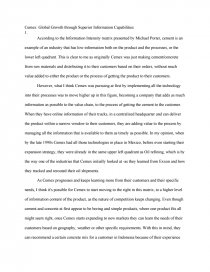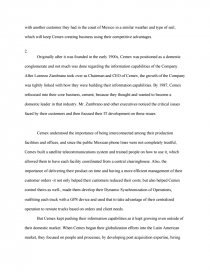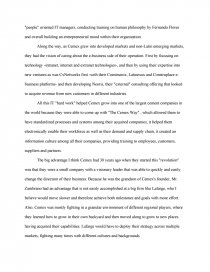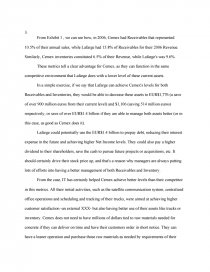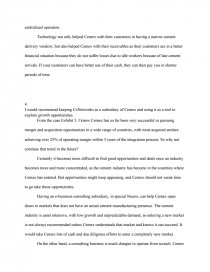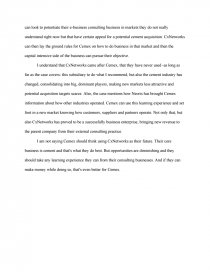Cemex: Global Growth Through Superior Information Capabilities
Essay by Kill009 • April 29, 2012 • Research Paper • 1,739 Words (7 Pages) • 2,553 Views
Essay Preview: Cemex: Global Growth Through Superior Information Capabilities
Cemex: Global Growth through Superior Information Capabilities
1.
According to the Information Intensity matrix presented by Michael Porter, cement is an example of an industry that has low information both on the product and the processes, or the lower left quadrant. This is clear to me as originally Cemex was just making cement/concrete from raw materials and distributing it to their customers based on their orders, without much value added to either the product or the process of getting the product to their customers.
However, what I think Cemex was pursuing at first by implementing all the technology into their processes was to move higher up in this figure, becoming a company that adds as much information as possible to the value chain, to the process of getting the cement to the customer. When they have online information of their trucks, in a centralized headquarter and can deliver the product within a narrow window to their customers, they are adding value to the process by managing all the information that is available to them as timely as possible. In my opinion, when by the late 1990s Cemex had all those technologies in place in Mexico, before even starting their expansion strategy, they were already in the same upper left quadrant as Oil refining, which is by the way one of the industries that Cemex initially looked at -as they learned from Exxon and how they tracked and rerouted their oil shipments.
As Cemex progresses and keeps learning more from their customers and their specific needs, I think it's possible for Cemex to start moving to the right in this matrix, to a higher level of information content of the product, as the nature of competition keeps changing. Even though cement and concrete at first appear to be boring and simple products, where one product fits all might seem right, once Cemex starts expanding to new markets they can learn the needs of their customers based on geography, weather or other specific requirements. With this in mind, they can recommend a certain concrete mix for a customer in Indonesia because of their experience with another customer they had in the coast of Mexico in a similar weather and type of soil, which will keep Cemex creating business using their competitive advantages.
2.
Originally after it was founded in the early 1900s, Cemex was positioned as a domestic conglomerate and not much was done regarding the information capabilities of the Company. After Lorenzo Zambrano took over as Chairman and CEO of Cemex, the growth of the Company was tightly linked with how they were building their information capabilities. By 1987, Cemex refocused into their core business, cement, because they thought and wanted to become a domestic leader in that industry. Mr. Zambrano and other executives noticed the critical issues faced by their customers and then focused their IT development on those issues.
Cemex understood the importance of being interconnected among their production facilities and offices, and since the public Mexican phone lines were not completely trustful, Cemex built a satellite telecommunications system and trained people on how to use it, which allowed them to have each facility coordinated from a central clearinghouse. Also, the importance of delivering their product on time and having a more efficient management of their customer orders -it not only helped their customers reduced their costs, but also helped Cemex control theirs as well-, made them develop their Dynamic Synchronization of Operations, outfitting each truck with a GPS device and used that to take advantage of their centralized operation to reroute trucks based on orders and client needs.
But Cemex kept pushing their information capabilities as it kept growing even outside of their domestic market. When Cemex began their globalization efforts into the Latin American market, they focused on people and processes, by developing post acquisition expertise, hiring "people" oriented IT managers, conducting training on human philosophy by Fernando Flores and overall building an entrepreneurial mood within their organization.
Along the way, as Cemex grew into developed markets and non-Latin emerging markets, they had the vision of caring about the e-business side of their operation. First by focusing on technology -intranet, internet and extranet technologies-, and then by using their expertise into new ventures as was CxNetworks first -with their Construmix, Latinexus and Construplace e-business platforms- and then developing Neoris, their "external" consulting offering that looked to acquire revenue from new customers in different industries.
All this IT "hard work" helped Cemex grow into one of the largest cement companies in the world because they were able to come up with "The Cemex Way" , which allowed them to have standardized processes and systems among their acquired companies, it helped them electronically enable their workforce as well as their demand and supply chain, it created an information culture among all their companies, providing training to employees, customers, suppliers and partners.
The big advantage I think Cemex had 30 years ago when they started this "revolution" was that they were a small company with a visionary leader that was able to quickly and easily change the direction of their business. Because he was the grandson of Cemex's founder, Mr. Zambrano had an advantage that is not easily accomplished at a big firm like Lafarge,
...
...
